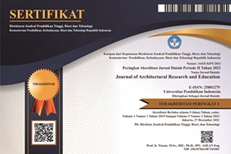Sustainable Strategy for Malioboro’s Pedestrian Area Using Thermal Comfort Simulation
Abstract
Thermal comfort is an important factor in the development of the Malioboro Area, as part of the The Cosmological Axis of Yogyakarta and Its Historic Landmarks, which has been designated as a world cultural heritage. This area is planned to become a pedestrian zone, supporting the city’s sustainability in addressing microclimate issues. This study aims to address thermal comfort issues on Malioboro Street by utilizing microclimate indicators and developing strategies for a sustainable environment. Using a qualitative SWOT analysis and quantitative ENVI-met software simulations, the study examines factors like air temperature, surface temperature, relative humidity, wind speed, and CO2 emissions in December 2023. Results show air temperatures in Segment 2 (from the south side of Grand Inna Malioboro to the south side of the The Regional Parliament Building of Yogyakarta) range from 31.44°C to 31.81°C, with surface temperatures between 38.62°C and 40.73°C, presenting significant thermal discomfort. Recommendations include optimizing green spaces, using light and porous materials, maintaining shade-providing vegetation, and planning building geometry to support air circulation. This study emphasizes the importance of integrating physical elements in urban planning to improve thermal comfort, enhance Malioboro’s cultural and tourism appeal, and make it a sustainable, functional, and aesthetically pleasing public space.
Keywords
Full Text:
PDFReferences
Adityo. (2016). PENINGKATAN KENYAMANAN TERMAL KORIDOR JALAN MELALUI DESAIN TATA VEGETASI BERBASIS SIMULASI Studi kasus : jalan Supadi, Kotabaru, Yogyakarta. Jurnal Arsitektur KOMPOSISI, 11(3), 159–168.
Aqila, U. F., & Saputra, A. (2022). KAJIAN KETERSEDIAAN DAN KEBUTUHAN RUANG TERBUKA HIJAU DI KAWASAN MALIOBORO KOTA YOGYAKARTA. Universitas Muhammadiyah Surakarta.
Balai Pengelolaan Kawasan Sumbu Filosofis. (2022). CONSERVATION MANAGEMENT PLAN SUMBU FILOSOFI.
Bao, J., Xu, L., Shi, Y., Ma, Q., & Lu, Z. (2023). The Influence of Street Morphology on Thermal Environment Based on ENVI-met Simulation: A Case Study of Hangzhou Core Area, China. ISPRS International Journal of Geo-Information, 12(8). https://doi.org/10.3390/ijgi12080303
Dinas Perhubungan Daerah Istimewa Yogyakarta. (2022). Kajian Pengurangan Karbon di Daerah Istimewa Yogyakarta.
Febriarto, P. (2016). TATA HIJAU PADA RUANG JALAN MENUJU KENYAMANAN TERMAL IKLIM MIKRO Studi Kasus: Jalur Pedestrian, Penggal Jalan Slamet Riyadi Di Surakarta. LOSARI: Jurnal Arsitektur Kota Dan Pemukiman, 111–116.
Ihsan, M., Khushari, B., Suparma, L. B., & Kanitpong, K. (2022). INVESTIGASI SIFAT TERMAL PERMUKAAN PERKERASAN JALAN. SIPILsains, 12(1), 71–78.
Kurniawati, U. F. (2021). Dampak Perubahan Penggunaan Lahan Terhadap Besaran Stok Karbon di Kota Surabaya. JURNAL PENATAAN RUANG, 16.
Nazar, M. S., Irawan, M. Z., & Wibisono, B. H. (2022). Analisis Dampak Penerapan Semi Pedestrian Malioboro Terhadap Kinerja Jaringan Jalan Di Kawasan Sumbu Filosofi Dan Sekitarnya. Universitas Gadjah Mada.
Nolasari, A. B., Toyyibah, W., Kurniawan, A., S, D. R. W., Chandra, M. F. W., & Koerniawan, M. D. (2023). Analisis Iklim Mikro Kawasan Berdasarkan Kerapatan Bangunan dan Vegetasi di Kawasan Institut Teknologi Bandung (ITB) Kampus Ganesha Bagian Selatan. REKSABUMI, 2(2), 75–86. https://doi.org/10.33830/reksabumi.v2i2.5039.2023
Octarino, C. N. (2022). KAJIAN DAMPAK POLA MASSA BANGUNAN TERHADAP IKLIM MIKRO DI AREA PERMUKIMAN. RUSTIC, 2(1), 1–9. https://doi.org/http://ojs.itb-ad.ac.id/index.php/RUSTIC
Octarino, C. N., & Kristiadi, A. (2019). KARAKTERISTIK IKLIM MIKRO DI RUANG PUBLIK Studi Kasus: Jalur Pedestrian Malioboro, Yogyakarta. Journal of Architecture and Built Environment, 1(2), 6–9. https://doi.org/10.52429/grid.v1i2.336
Pratiwi, N., Santosa, D. B., & Ashar, K. (2018). ANALISIS IMPLEMENTASI PEMBANGUNAN BERKELANJUTAN DI JAWA TIMUR. JIEP, 18(1). https://jurnal.uns.ac.id/jiep/article/download/18188/15342
Pratiwi, R. D., Fatimah, I. S., & Munandar, A. (2019). PERSEPSI DAN PREFERENSI MASYARAKAT TERHADAP INFRASTRUKTUR HIJAU KOTA YOGYAKARTA. LANSKAP INDONESIA, 11, 33–42. https://doi.org/10.29244/jli.11.1.2019.33-42
Pratiwi, S. N. (2018). A REVIEW OF MATERIAL COVER FEATURES FOR MITIGATING URBAN HEAT ISLAND. International Journal on Livable Space, 3(2), 71–80. https://doi.org/10.25105/livas.v3i2.3196
Prayoga, S. E., & Kusumawanto, A. (2019). THERMAL COMFORT SIMULATION ON CIK DITIRO CORRIDOR. DIMENSI (Journal of Architecture and Built Environment), 46(1), 67–78. https://doi.org/10.9744/dimensi.46.1.67-78
Santi, S., Belinda, S., & Rianty, H. (2019). IDENTIFIKASI IKLIM MIKRO DAN KENYAMAN TERMAL RUANG TERBUKA HIJAU DI KENDARI. NALARs, 18(1), 23. https://doi.org/10.24853/nalars.18.1.23-34
Wali Kota Yogyakarta. (2024). Peraturan Wali Kota Yogyakarta Nomor 49 Tahun 2024 tentang Rencana Tata Bangunan dan Lingkungan Kawasan Malioboro.
DOI: https://doi.org/10.17509/jare.v7i1.83438
Refbacks
- There are currently no refbacks.
Copyright (c) 2025 Journal of Architectural Research and Education

This work is licensed under a Creative Commons Attribution-NonCommercial-ShareAlike 4.0 International License.

This work is licensed under a Creative Commons Attribution-ShareAlike 4.0 International License.








